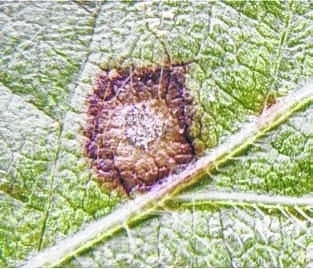
Frogeye leaf spot is a disease that can be found in some soybean fields across Ohio but the severity is often low and does not warrant treatment. However, severity has increased in recent years and susceptible varieties of soybean seed are still being sold.
Dr. Anne Dorrance, OSU Extension state specialist in plant pathology, says this year has the potential to be a perfect storm for frogeye leaf spot. There was a lot of inoculum at the end of last year and the very mild winter likely did not destroy it. The transition to a La Niña is predicted to bring a drought so this could hinder the disease, as it prefers wet conditions. However, that solution comes with its own set of problems.
Symptoms of this disease are small lesions, gray spots with reddish-brown to purple borders, on top of the leaf. On the underside of the leaf, the lesion appears brown to gray with tiny dark “hairs”. The younger leaves of the plant are more susceptible than the older leaves. In years where rainfall and humidity persist, stems and pods may become infected as well. The lesions on the pods are reddish-brown and may appear shrunken. The older lesions turn brown to dark gray, usually with a narrow, dark brown border.
As mentioned previously, there was a lot of inoculum at the end of the year because the fungus, Cercospora sojina, will survive on crop residue left on the soil surface. Foliar symptoms may appear 7 to 12 days after inoculation. Once the lesions have developed, the spores can be readily spread throughout the plant, field and surrounding fields. At or after growth stage R5, there is very little impact on the plant, but if symptoms occur prior to or at flowering, the fungus will continue to infect new soybean leaves as they form and there may be enough disease pressure build up by the end of the season to impact yield. According to Dorrance:
When this disease does appear on susceptible varieties, a fungicide application can reduce the level of infection. However, recent reports from the southern US and states to the west of us indicate that the fungus has adapted and some chemistries are no longer effective. The soybean pathology lab at Ohio State will be evaluating samples this summer for sensitivity to some of the fungicides.
Managing the disease
Management is important to controlling this disease. There are four key things you can do to manage the disease:
1. Plant varieties resistant to Frogeye leaf spot. Rcs3 is the gene resistant to all populations of frogeye.
2. Scout susceptible varieties for the presence of frogeye.
3. If frogeye lesions are found on plants prior to soybean growth stage R3, an application of fungicide may be needed. If the forecast is for wet, humid weather, then it is likely the disease severity will increase and a fungicide application will be economical.
4. If fields were infected last year, burying crop residue and crop rotation are critical. Rotating away from soybeans for at least one year is recommended, especially if residue cannot be completely buried.
If you think you may have this disease early in the season, and are concerned about how to proceed, do not hesitate to contact the Extension office. We would also like to collect frogeye samples to submit to the pathology lab for resistance evaluation. You can contact us at 937-484-1526 or [email protected].
Source: Dorrance, A. E., & Mills, D. (2011, January 3). FROGEYE LEAF SPOT OF SOYBEAN. Retrieved May 24, 2016, from http://ohioline.osu.edu/factsheet/AC-53


